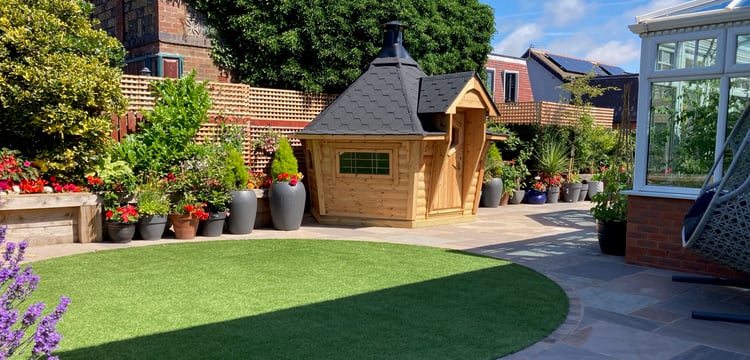How Do I Prepare My Garden For A BBQ Cabin?
So you’ve got your BBQ cabin installation date booked, you’ve told your family and friends, and are planning what you’ll cook to christen your new cabin! But wait- “Is my garden ready for a BBQ cabin?” you might be asking yourself, as you look out your window at the space waiting to be filled by a cosy log cabin.
To fill your time whilst you eagerly await your BBQ hut or Arctic bar, here are some things we recommend that you can do to prepare your land for your new cabin. Because, as fantastic as they are, anything beats waiting by the front door for the installation team!
A Few Tips: Getting properly prepared
Measuring your space: When measuring the space in your garden to see if a particular BBQ cabin or Arctic bar will fit, it helps to pretend the cabin is a circle rather than a hexagon or octagon, as it can be very challenging getting all of the angles correct. For example, the overall size of the 10m2 cabin is 5m at its widest point. If you need help measuring the space for your cabin, our team can conduct a free site survey to advise you.
Removing roots and tree stumps: A particular pain in the ar(ctic)se for cabin owners-to-be is having to dig out a stubborn old tree stump. Complete tree stump removal is not usually necessary and in many cases actually causes a problem, as doing so would disturb the well-compacted soil around it. Ideally, a tree stump should be cut off at ground level and killed to ensure it doesn't return - we don’t want your BBQ hut turning into a treehouse!
Be there on build day: You will need to be present on the installation day, as our team will need you to confirm the exact location of the base and the building.
Your BBQ cabin or garden bar base is usually installed on the same day as the rest of the cabin, so you won’t have to wait around or have multiple teams visiting your property across a few days.
Key Tasks: get set for your BBQ cabin install
- Make sure the designated cabin area is clear of obstructions like existing buildings, plants, shrubs, and tree stumps.
- Ensure the access area is free of obstructions so the cabin installation team can bring in the cabin parts and their tools.
- Make sure there is access to water nearby (like a hosepipe or tap) so the team can mix the postcrete to set the base posts into the ground.
- Ensure any proprietary works advised by Arctic Cabins have been carried out.
Ground Conditions
Our cabin installation team is used to working with many different ground types- such as soil, grass, gravel or existing hard-standing bases, like a patio or a concrete base. The type of surface that your BBQ cabin or garden bar will be sat on will affect the type of base used by our team for your cabin.
Cabin bases for soil and grass surfaces:
Most of the time we will use a composite-post base. These posts are made from recycled plastic resin, that are secured into the ground with fast curing post-crete. An alternative is a ground screw method, which involves giant posts of variable length that resemble a giant woodscrew being drilled into the ground and the cabin base being placed on top.
Ideally, the ground where your hut will sit should be fairly flat, so the cabin is close to the ground, preventing a large step up into the cabin. If your chosen log cabin location isn’t entirely flat, there’s no need to make a mountain out of a molehill, as we can accommodate a slope of up to 50cm with our composite-post base system, and even greater slopes can be accommodated with the ground screw base system.
The most important thing is that the ground is well compacted, which will allow the cabin installation team to drill into the ground without it collapsing into the hole. This also helps hold the Postcrete around the composite posts or hold the ground screws, whichever is being used.
Cabin bases for gravel surfaces:
If your cabin is being installed on a gravel surface, the gravel and weed membrane will need to be removed. Otherwise, the membrane will get tangled up when the posts are installed, or the gravel will fill the post holes.
Cabin bases for patio or concrete surfaces:
For hardstanding surfaces, we use the previously mentioned composite-post base, but in a slightly different way. Short composite posts will sit on the hardstanding surface and raise the base frame away from the ground, so there is no need for digging or additional concrete.
It is, however, important to check that your patio slabs are on a solid concrete base, to avoid any movement when the cabin is installed- you don’t want your cabin slowly sliding down your garden!
If your patio slabs are sat on a base of sand and can be lifted, the slabs should be removed altogether and the ground returned to soil.
Before our team installs your cabin, take some time to perform any necessary maintenance to ensure a secure and safe foundation.
Cabin bases for partial hardstanding surfaces:
“But what if my cabin will be sat half on grass and half on concrete?”- We can accommodate that too! For this, we would use a “part-pegged base”. This is a mix of composite posts that are Post-creted into the ground (in the soil section) and the short composite posts that sit on the hardstanding surface.
Final Thoughts:
If you haven't already had your free site survey, request one with a member of our team and they can help you measure out your cabin space and will be able to offer any bespoke advice on how to prepare your garden for installation.
Got a specific question about log cabin installations? Contact us!










_feature.jpg?width=750&height=375&name=Arctic%20Cabins_De%20Wolf_2x17m%20joined%20with%20Bar%20(21)_feature.jpg)










